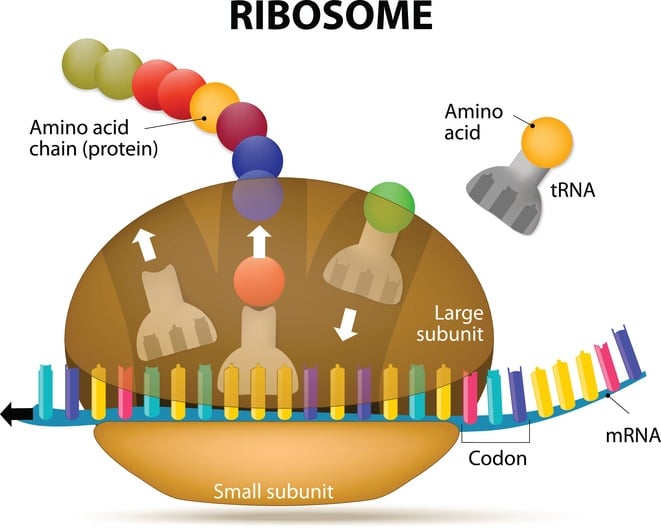In essence, protein expression and purification methods aim to produce functional proteins to deduce the structural, physical, and chemical attributes of a protein for biomedical research. Protein expression involves understanding the way in which proteins are synthesized, modified, and regulated in living organisms, while protein purification involves isolating one, or multiple, proteins from a complex mixture. Few proteins, however, are abundant in sufficient quantities to be isolated from their native hosts. Often, the researcher is tasked with figuring out ways to obtain an adequate concentration of the target molecule to facilitate protein expression and purification. After proteins are expressed sufficiently, they must be purified so that the desired protein(s) are separated from any other bioactive molecules within the cell sample.
The Basics of Protein Expression and Purification
Protein expression is a general term used to describe how proteins are synthesized. In the body, protein expression is done through transcription and translation, involving a cascade of chemical signals and existing proteins in the microenvironment. The cellular machinery of transcription and translation is too complex for humans to engineer completely, which is why lab-born protein expression utilizes living cells to do most of the work. The traditional laboratory approach was performed through a technique called recombinant protein expression. This technique involves transfecting cells with a vector containing a target DNA template and then culturing the cells so that they transcribe and translate the desired protein. Other protein expression systems include cells derived from yeasts, baculoviruses or insects, mammals, and even filamentous fungi. You can check out the list of our suppliers in protein purification.
Once the proteins within the cells are generated in sufficient quantities they must be collected and purified. Here, the proteins are extracted from the cell culture via cell lysis. The lysate is often a messy mixture of cellular components unsuitable for most applications, so an enriched sample of target protein must be obtained. In most downstream experiments, effective purification is vital for determining the specific function, structure and interactions of the protein of interest. Once a protein is purified, its enzymology, affinity for particular substrates, and even ability to catalyze particular reactions can be assessed. Such protein expression and purification techniques, together, are commonly used as preliminary steps before determining pharmaceutical cytotoxicity, understanding immune response systems, or for studies on cell regulation.
Methods of Magnetic Protein Expression and Purification
There exist many traditional protein expression and purification methods from a crude sample. Common techniques are often time consuming and require constant handling, which inadvertently may lead to contamination. Comparatively, magnetic beads can be used to purify proteins, and offer an easy protocol with minimal hands on steps. In magnetic protein expression and purification first, the sample is lysed, then magnetic beads are added and incubated with the sample. During incubation, the magnetic beads can bind tightly to the target proteins, which are then collected and separated from the rest of the sample using a magnetic field. Such technologies have a number of attributes. They can be applied to very diluted samples, or those that only contain a very small quantity of the target protein.
Outside of protein purification, magnetic beads can also be used to quantify the results of an expression reaction. For example, in research magnetic beads have been used in tandem with rt-PCR to quantify nucleic acids in a complex sample. In another study, magnetic beads were used in flow cytometry to quantify AFB1, a metabolite of Aspergillus fungi. Additional, magnetic protein expression and purification technologies are efficient for both small and large-scale processes, and will work effectively and efficiently for microliter, to multi-liter, sized starting samples.
Research and medicine is dependent upon the ability to control protein expression and purification in order to generate large, pure populations of proteins. Advancing science has given us the ability to perform protein expression and purification at the benchtop, providing more abundant isolated protein targets from just a few experiments than ever before. Magnetic protein purification offers a user-friendly, straightforward approach that can offer faster testing times and less risk of human error over other traditional methods. Additionally, tools used in magnetic protein expression and purification methods are widely accessible, and affordable, making them the premier choice for endeavors in protein expression and purification.
Related news
Published on July 31, 2018 and updated on January 11, 2024.





